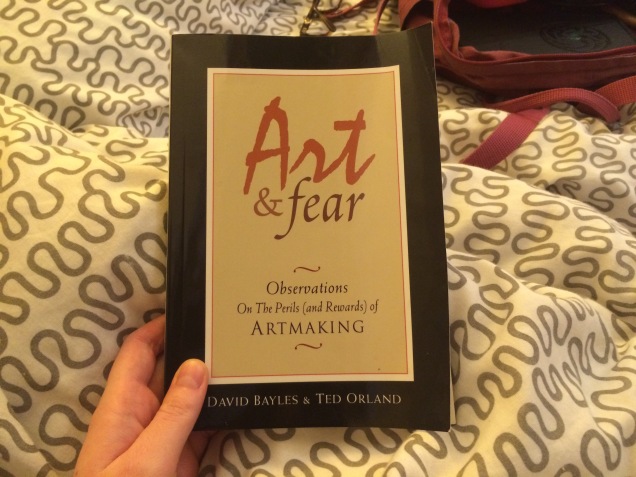
In January I read 4 books! They were a mix of contemporary Japanese fiction, fun non-fiction essays, and a graphic novel.
Kinshu: Autumn Brocade by Teru Miyamoto ★★★☆☆
This book was okay. It was recommended on Goodreads because I had read quite a lot of Murakami, Banana Yoshimoto, and Yoko Ogawa, but aside from being set in contemporary Japan it didn’t have much in common with any of these authors’ writing. It was in epistolary form of letters between ex-husband and wife, which I quite liked. However, I think this book fell into the trap of the characters writing a lot of background information in the letters, obviously intended to inform the reader, which seems a bit unbelievable and forced sometimes. But I guess it’s difficult to get around that! I found the ex-husband to be unpleasant in a really exaggerated way, so much so that his character was a bit unbelievable. It was a fairly enjoyable read overall.
Art & Fear by David Bayles and Ted Orland ★★★★★
Every art student should read this book! It is quite short but packed with revolutionary ideas about art-making, creative blocks and crises, how to persist and what being an artist means. It’s kind of like a self-help book aimed very specifically at artists and art students and I really loved it. It was like having a tutorial or crit where you come out with a new perspective, feeling like everything is going to be okay.
What veteran artists share in common is that they have learned how to get on with their work. Simply put, artists learn how to proceed, or they don’t.
Bayles and Orland pitched radical yet simple ideas to me that I had never considered. I liked their argument that “art is made by ordinary people”, and that calling someone creative is redundant because all humans have the capacity for creativity – what matters is how and if you utilise it! The only criticism I have of this book is that 99% of examples they used were male artists and musicians. And they were mostly white and Western too! Where’s the diversity?
Lost At Sea by Bryan Lee O’Malley ★★☆☆☆
I don’t have much to say about this book, other than I expected better. I am a big fan of O’Malley’s graphic novels; I love Scott Pilgrim and have read the whole series, and read Seconds last year and quite enjoyed that…he normally writes narrative really well, but this book didn’t seem to go anywhere. Maybe it is something more suited to when I was a teenager and had more angst than 21 year old me, but I did feel this story was just lacking, and nothing was really explained to a satisfactory extent. Sad, because I really liked the premise! I think it just fell short of my expectations.
Reading The L Word: Outing Contemporary Television by a number of writers ★★★★★
I really enjoyed this. It is a compilation of essays, interviews and think-pieces on the TV show The L Word, which if you are not aware was a seminal TV series about a group of lesbian and bisexual women living in LA. The L Word was the first of its kind, so it had a lot to live up to in terms of showing realistic portrayals of queer women, and conveying the diversity of the LGBTQ+ community.
Something I found really interesting which cropped up a few times in this book was the balance The L Word had to strive for to receive good ratings – attract the attention of straight people as well as queer women – whilst also remaining true to real life, but not so much as to alienate the majority of viewers. Representation is a difficult thing when you have to pander to ordinary media standards in order to keep your vision going.

Also, it was just really fun to read critical analysis or more fan-based pieces on the TV show that I watch ALL the time! Because it was so groundbreaking, and lesbian and bisexual representation is sparse on the ground, everyone has something to say about it, and it was fascinating to read the diversity in opinion. I think The L Word can be harshly criticised for its, at times, very problematic elements, but we can also acknowledge these, and praise it for what it did achieve. I am glad the book took up issues of race, trans representation, and bisexual erasure though, because these need to be addressed. It’s good that these conversations are happening in response to something we love to watch, but not unconditionally. (It should also be noted for anyone that wants to read it that the book was published at the end of Season 2, so the pieces in the book only consider the show up till this point.)
Next on my list for February are Fingersmith by Sarah Waters, and A Winter Book by Tove Jansson.